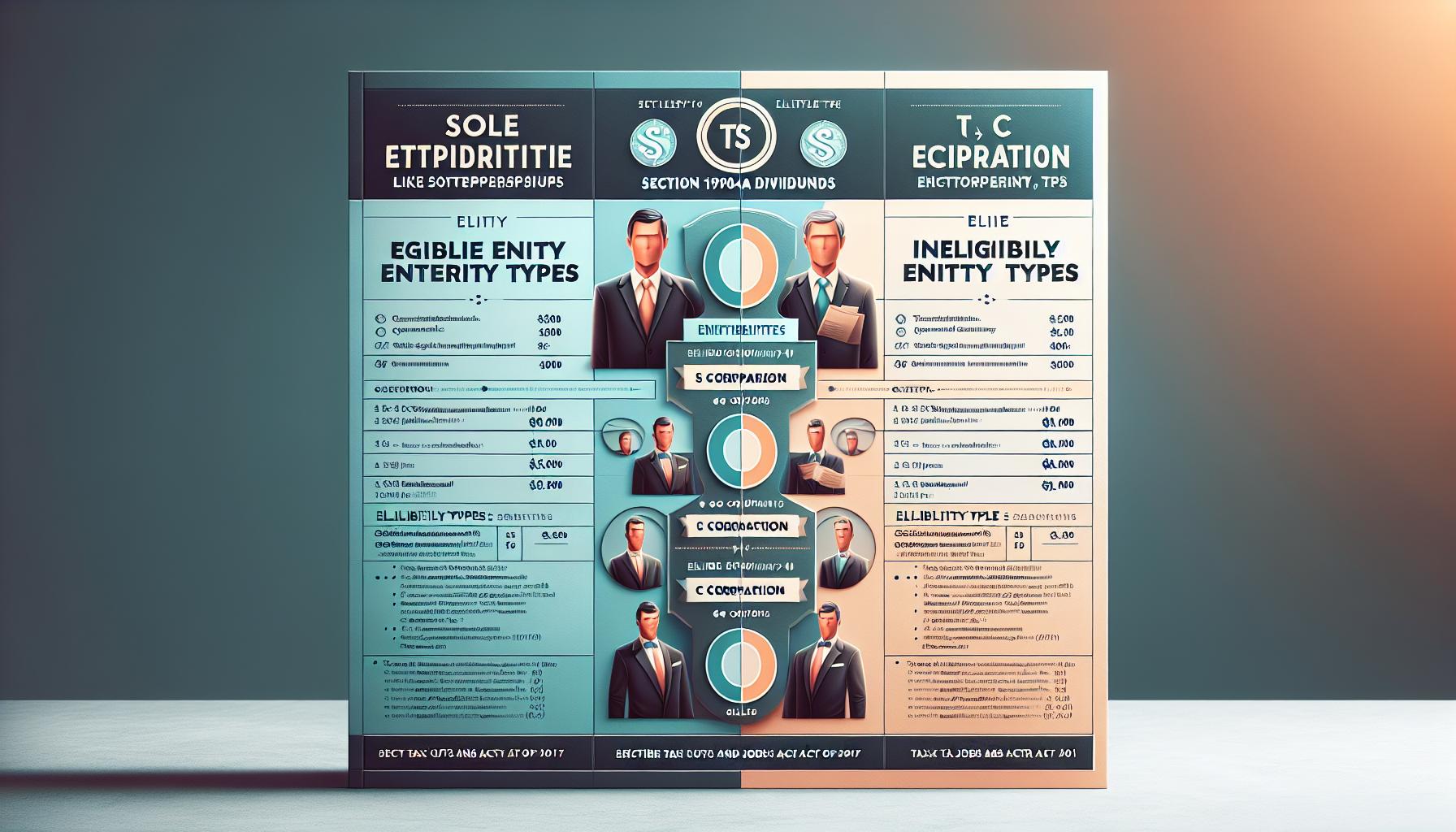Maximizing Tax Benefits: Understanding and Applying Section 199A Dividends
If you’re like me, you’re always on the lookout for ways to maximize your income and minimize your tax liability. That’s where Section 199A dividends come into play. It’s a part of the Tax Cuts and Jobs Act of 2017, and it’s a game-changer for investors and business owners alike.
Section 199A dividends, also known as Qualified Business Income (QBI) deductions, can offer significant tax benefits. It’s a complex area of tax law, but I’m here to break it down. So whether you’re a seasoned investor or a small business owner, stick around. I’ll be shedding some light on the intricacies of Section 199A dividends and how they can benefit you.
What are Section 199A Dividends?
These, my friends, are more than just a compilation of words and numbers. They’re a massive sigh of relief for investors and small business owners. Imagine a tool that slices off a portion of your tax! That’s what Section 199A dividends are. They are QBI deductions or Qualified Business Income deductions if we’re going for the full name.
Now let’s wade into the details. The Tax Cuts and Jobs Act of 2017 triggered the start of this. As an incentive to spur the growth of businesses and investments, these deductions were made a part of this act.
I often consider Section 199A dividends as a special delicacy on the tax buffet. They’re not for everybody. They’re specifically designed for pass-through entities – yes I’m referring to you, owners of sole proprietorships, partnerships, S corporations, and some trusts and estates. What does that mean for them? Well, brace yourself for up to a 20% deduction on your qualified business income!
Below, I’ve created a handy little markdown table to illustrate what entities are eligible for Section 199A dividends.
| Entity Type | Eligible for 199A Dividends |
|---|---|
| Sole Proprietorships | Yes |
| Partnerships | Yes |
| S Corporations | Yes |
| Trusts and Estates | Some |
What about other businesses, though? I hear you. Businesses, like C corporations, unfortunately, can’t enjoy these dividends. They’ve got another type of party happening – they get their benefits from the massive corporate tax rate cut from 35% to 21% rolled out by the same Act.
Yes, it’s complicated. But it’s also a game-changer. For those in the right business structure, the tax savings from the 199A deductions can be substantial. And with all game-changers, there are complexities, and specifics. Let’s delve deeper into those next.
Understanding the Tax Cuts and Jobs Act of 2017

Unveiling the Tax Cuts and Jobs Act of 2017, let’s demystify this legal jargon to something you can understand. Simply put, it’s a significant tax reform that came about to stimulate the US economy. Its primary goals were business growth and investment stimulation.
The TCJA, as it’s often known, made some substantial changes to the tax landscape. For one, it reduced the corporate tax rate from 35% to 21%. Before you think this is the be-all and end-all, it’s important to realize that this benefit is exclusive to C corporations.
You may be wondering, “What about pass-through entities?” That’s where Section 199A dividends, also known as QBI deductions, come into play. These deductions were specifically designed for pass-through entities. That includes sole proprietorships, partnerships, S corporations, and some trusts and estates.
| Eligible Entity Types | Not Eligible Entity Type |
|---|---|
| Sole Proprietorships | C corporations |
| Partnerships | |
| S corporations | |
| Some trusts and estates |
The beauty of Section 199A dividends is the tax savings they offer. If you’re in the right business structure, these savings can be substantial. They can really tip the scales in favor of pass-through entities. I can’t stress enough how it’s vital to understand the specifics of these deductions and consult with a tax professional. The TCJA and these deductions are tools that, used correctly, can bring about significant benefits.
Qualified Business Income (QBI) Deductions Explained
As we delve deeper into the nuances of Section 199A dividends, it’s pivotal to understand their underlying structure, known as Qualified Business Income (QBI) deductions. Why so? Because these deductions are integral to unlocking the potential tax benefits that come with Section 199A.
You might ask, “What exactly are these QBI deductions?” Think of them as a boon to small businesses and investors. Here, you receive a deduction on your taxable income derived from a qualified trade or business. It’s a financial advantage, allowing you to keep more profits in your pocket.
But remember, not all entities qualify for these deductions.
Eligibility extends to certain types of business structures referred to as pass-through entities. These include:
- Sole proprietorships
- Partnerships
- S Corporations
- Certain trusts and estates
C corporations, on the other hand, didn’t get an invite to the QBI deductions party. But don’t shed tears for them just yet. These corporations got a piece of the tax benefits pie through a significant reduction in their corporate tax rate – a drop from the previous hefty 35% to a more manageable 21%.
Breaking down QBI deductions even further though, it’s not a one-size-fits-all situation. The deductions can vary based on:
- The type of your business
- The taxable income amounts
- Existence of W-2 wages or qualified property
Yes, it’s a little complex and demands a deeper understanding. Navigating through the specifics of these deductions, and realizing the need to rope in a learned tax professional is all part of the game. And it’s a game you’ll want to play, as the rewards, in the form of substantial tax savings, are well worth the effort. Consult with a tax professional to understand your eligibility and maximize these benefits. Knowledge definitely pays – quite literally – in the realm of Section 199A dividends.
Who Can Benefit from Section 199A Dividends?
Let’s delve into the specifics of who can truly benefit from Section 199A dividends or QBI deductions. As pointed out earlier, the main beneficiaries are typically pass-through entities. That includes sole proprietorships, relevant trusts, estates, partnerships, and S corporations.
Now if someone’s operating a small business as an individual entrepreneur (a sole proprietor), they’re eligible. So, those running enterprises from their own homes, freelancers, and individual contractors can leverage Section 199A.
Also, businesses that function as partnerships and S Corporations fall into the beneficiaries’ list as well. In essence, if your business isn’t paying corporate income tax separately, you’re on the list.
| Entity | Eligibility for 199A Dividends |
|---|---|
| Sole Proprietorships | Yes |
| Individual Entrepreneurs | Yes |
| Partnerships | Yes |
| S Corporations | Yes |
| C Corporations | No |
Even for some trusts and estates, these deductions are attainable. However, there is still a catch. If the income from these entities exceeds a certain threshold, ($157,500 for single filers, and $315,000 for joint filers), the type of business (specified service trade or business) can affect the ability to take the deduction. This is a critical point to remember when considering the advantages of Section 199A dividends.
Hence I must stress that while these deductions can offer sizeable tax benefits, understanding the nuances is key. The parameters defining eligibility are complicated with many determining factors. Yet, the potential savings make it worth exploring further.
And here’s where professional advice can truly pay off. An experienced tax consultant can help you navigate these complexities and tailor your business model or income reporting to maximize your benefits. So, it’s a wise decision to get in touch with one to help you understand and utilize Section 199A dividends to their full extent.
How to Maximize Tax Benefits with Section 199A Dividends

Now let’s look at a few strategies that can help you unlock the full potential of Section 199A dividends. These tax optimization strategies should always be guided by a certified tax professional to ensure they’re tailored to your specific circumstances.
Choosing the Right Business Structure
Your entity’s structure plays a pivotal role in your eligibility for QBI deductions. As we mentioned earlier, C corporations can’t enjoy these dividends but they do benefit from a reduced corporate tax rate. However, pass-through entities such as sole proprietorships, partnerships, S corporations, and some trusts and estates can. So, one way to maximize these dividends is by choosing a business structure that’s eligible for this deduction.
Boosting QBI
The more Qualified Business Income you generate, the bigger your possible Section 199A dividend. Remember, the definition of QBI includes the net amount of items of income, gain, deduction, and loss connected with your U.S trade or business. Therefore, boosting your net business income can result in higher 199A deductions. Consulting with a tax professional can often reveal strategies to lawfully boost this figure.
Proper Income Classification
It’s important to correctly classify your income and ensure it meets the criteria for QBI. Misclassifications can lead to missed 199A deductions. Consult with your tax professional to help you classify your income correctly.
In the world of tax optimization, one-size-fits-all answers are rare. Factors such as your overall tax situation, income bracket, and specific kind of business play a significant role when it comes time to apply these strategies. This is why consulting with a tax advisor is key – they’ll help ensure you’re taking full advantage of Section 199A dividends and other tax breaks available.
The goal isn’t just to save on taxes – it’s to structure your finances in a way that supports sustainable, profitable growth. So, don’t hesitate to dive deep into the details of Section 199A dividends. It could be your ace in the hole, leveraging your investments, and giving your business a significant, well-deserved boost.
Conclusion
Section 199A dividends offer a valuable opportunity for tax savings. They’re a boon for investors and small business owners, particularly those operating as pass-through entities. But remember, it’s not a one-size-fits-all solution. Maximizing these dividends takes strategic planning. Adjusting your business structure, enhancing your QBI, and correctly classifying income are all crucial steps. Don’t go it alone – professional advice is key to navigating the complexities of these deductions. So, with the right guidance, you can leverage Section 199A dividends to fuel your business growth. It’s time to delve deeper into this potential game-changer for your investments and business.
Frequently Asked Questions
What are Section 199A dividends or Qualified Business Income (QBI) deductions?
Section 199A dividends, commonly known as Qualified Business Income (QBI) deductions, are a tax relief measure for investors and small business owners included in the Tax Cuts and Jobs Act of 2017. They were designed to stimulate business growth and investments.
Who can benefit from Section 199A dividends?
Section 199A dividends are designed specifically for pass-through entities such as sole proprietorships, partnerships, S corporations, and some trusts and estates. Unfortunately, C corporations cannot benefit from these dividends.
How could Section 199A dividends lead to tax savings?
The tax savings from Section 199A deductions can be significant for those in the right business structure. But it’s essential to understand the complexities and specifics, as they may vary.
How can someone maximize the benefits of Section 199A dividends?
Strategies for maximizing benefits can include choosing the appropriate business structure, increasing Qualified Business Income (QBI), and classifying income correctly. Consultation with a tax professional is crucial because these strategies must be tailored to individual circumstances.
Is there a need to adjust finances to benefit from Section 199A dividends?
Yes, structuring finances in a way that supports sustainable, profitable growth is essential to optimize the potential benefits of Section 199A dividends.







